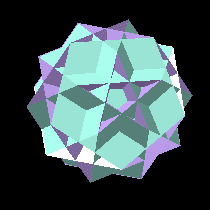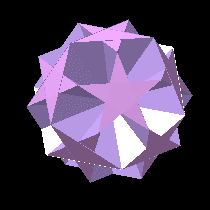
|
The icosidodecahedron has 12 pentagonal
faces in the planes of the dodecahedron and also 20 triangular faces in
the planes of the icosahedron. It can be formed by slicing off vertex
pieces from either the icosahedron or the dodecahedron. It is actually
the volume interior to both when they are placed as a reciprocal pair. |

|
The small ditrigonal icosidodecahedron
still has 20 triangular faces, but instead of pentagons it has
pentagram (five-pointed star) faces. The star faces cause the
triangular faces to intersect. Intersecting faces are a feature of all
the following uniform polyhedra.
|

|
The great ditrigonal icosidodecahedron
has
20 triangular and 12 pentagon faces as suggested by the name
"icosidodecahedron", but it differs from the basic icosidodecahedron
because the pentagon faces are deep within the structure. Three
triangles and three pentagons alternate around each vertex. We can see
the edges of the regular compound of five cubes, suggesting
relationships between the two configurations.
|

|
The dodecadodecahedron has two sets of
faces with the symmetry of the dodecahedron. These are outer pentagram
faces and deeper pentagon faces. The 24 face planes lie in 6 sets, each
consisting of 4 parallel planes.
|

|
The great dodecahemicosahedron has 12 pentagon faces in
the dodecahedral arrangement. These are joined by 10 (not 20; hence
"hemi") hexagon faces passing through the centre of the solid. |

|
The small icosihemidodecahedron can be recognised as
having the 20 triangular faces of the icosidodecahedron, but the
pentagon faces are missing. Instead, the triangular faces are joined by
6 decagon (ten-sided polygon) faces. Each decagon passes through the
centre of the solid and divides it into two congruent halves. |

|
The small dodecahemidodecahedron is a similar solid
using the pentagon faces of the icosidodecahedron and the same 6
decagon faces through the centre. This polyhedron and the previous one
together enclose the same volume as the icosidodecahedron. |

|
The small dodecahemicosahedron has 12 pentagram faces
in the dodecahedral planes and the 10 through-centre hexagon faces of
the hemicosahedron. |

|
The ditrigonal dodecadodecahedron has 12
pentagram faces, but now they are joined by 12 pentagon faces deep in
the structure. Three of each kind of face alternate around each vertex. As the solid rotates, deep cavities between the
pentagram arms are seen. |

|
The great icosidodecahedron has 20 triangular faces and
12 pentagram faces. Now the pentagram faces which are deep in the
structure too. |
 |
The great icosihemidodecahedron
has 20 triangular faces and 6 faces in the planes of a
dodecahedron. However, the 6 faces are not decagons but decagrams:
10-pointed star polygons. These decagrams enclose their centres three
times rather than twice as for a pentagram. They pass through the
centre of the solid and only their outer areas are visible, inside the
cups formed by groups of six triangle points. |

|
The great dodecahemidodecahedron is the only polyhedron on this page which has all star-polygon faces: it has 12 pentagrams and 6 decagrams.
|























